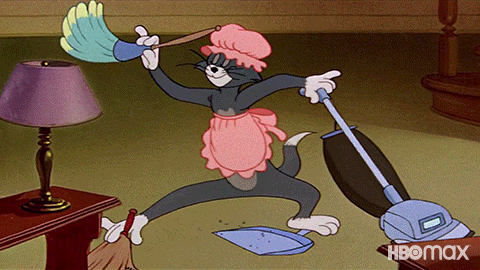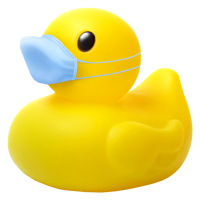
First of all, cleaning, sanitizing, and disinfecting are all crucial to maintaining health and keeping your house safe. How do you do each effectively and how are they actually different?
General cleaning removes dirt from objects by using water, soap, or other detergents, thus lowering the amount of germs present by physically removing them. Ideally, this should be done before trying to disinfect with chemicals to make the disinfection work as best as possible.
Cleaning:
- Physically removes dirt, dust, and debris from items and surfaces.
- While not necessarily killing germs, using soap or other detergents, can lower the overall amount of germs, reducing the spread of infection.
Sanitizing:
- Lowers the amount of germs on surfaces or objects to a safe level. This varies based on health standards and requirements for what is being sanitized.
- Lowers the risk of spreading the infection.
- Sanitizing kills at least 99.9% (3-log) of bacteria.
Disinfecting:
- Uses chemicals to kill germs/bacteria/microbes.
- Chemicals generally need to remain on a surface for a certain period of time for effect.
- Kills 99.9% or more (upwards of 99.9999%, or 6-log) of bacteria and microorganisms.
What Approach Should I Use?
The best way to get the results we all want, a clean environment, is to follow these guidelines and tips from the CDC.
- Clean and Sanitize high-touch areas regularly (doorknobs, light switches, phones, countertops etc…
- Routinely clean and disinfect your home; have a schedule you go by and use simple techniques such as: cleaning/wiping from top to bottom and in an “S” pattern. Dust after vacuuming since most vacuums also stir up some of the dust they don't catch.
- Clean Correctly; clean a surface with a general household cleaner first, rinse with water and then disinfect to properly kill germs.
- Use products safely. Always heed hazard warnings and follow label instructions on cleaners. Most require a certain amount of time to sit on a surface and disinfect but a lot of people “spray and wipe” simultaneously and this negates the disinfection process. Never mix cleaners and disinfectants unless the label indicates it's safe to do so, doing so can result in injury or even death.
- Handle waste properly. Place “no-touch” waste baskets for easy access around your home and office and avoid touching any contents when emptying them out.
The R4 Clean Process
There are always other options that are even more effective at killing all harmful bacteria and mold. We use the SteraMIST™ patented Binary Ionizing Treatment™ solution both residentially or commercially for disinfection. This treatment offers an amazing 99.9999% efficacy. If done after major cleaning of your space you can be confident it's germ and microbe free! We can give you an estimate for a quick and effective SteraMIST treatment.
Suplimental Reference Information
The Five Levels of Clean
The University of Virginia's Facilities Management uses the following indicators for determining the level of cleanliness. The lower the score higher the level of cleanliness.
Level 1 — Orderly Spotlessness indicators
- Floors and base molding shine and/or are bright and clean; colors are fresh.
- There is no buildup in corners or along walls.
- All vertical and horizontal surfaces have a freshly cleaned or polished appearance and have no accumulation of dust, dirt, marks, streaks, smudges, or fingerprints. Lights all work and fixtures are clean.
- Washroom and shower fixtures and tile gleam and are odor free. Supplies are adequate.
- Trash containers and pencil sharpeners hold only daily waste and are clean and odor free.
Level 2 — Ordinary Tidiness indicators (Same as Level 1 with the following exceptions)
- There can be up to two-days worth of dust, dirt, stains, or streaks on floors and base molding
- Dust, smudges, and fingerprints are noticeable on vertical and horizontal surfaces
Level 3 — Casual Inattention indicators
- Floors are swept or vacuumed clean, but upon close observation, there can be stains. A buildup of dirt and/or floor finish in corners and along walls can be seen.
- There are dull spots and/or matted carpet in walking lanes. There are streaks or splashes on base molding.
- All vertical and horizontal surfaces have obvious dust, dirt, marks, smudges, and fingerprints. Lamps all work and fixtures are clean.
- Trash containers and pencil sharpeners hold only daily waste and are clean and odor free.
Level 4 — Moderate Dinginess indicators
- Floors are swept or vacuumed clean, but are dull, dingy, and stained. There is a noticeable buildup of dirt and/or floor finish in corners and along walls.
- There is a dull path and/or obviously matted carpet in the walking lanes. Base molding is dull and dingy with streaks or splashes.
- All vertical and horizontal surfaces have conspicuous dust, dirt, marks, smudges, and fingerprints. Lamp fixtures are dirty, and some lamps (up to 5 percent) are burned out.
- Trash containers and pencil sharpeners have old trash and shavings. They are stained and marked. Trash containers smell sour.
Level 5 — Unkempt Neglect indicators
- Floors and carpets are dull, dirty, scuffed, and/or matted. There is a conspicuous buildup of old dirt and/or floor finish in corners and along walls. Base molding is dirty, stained, and streaked. Gum, stains, dirt, dust balls, and trash are broadcast.
- All vertical and horizontal surfaces have major accumulations of dust, dirt, smudges, and fingerprints, all of which will be difficult to remove. Lack of attention is obvious.
- Light fixtures are dirty with dust balls and flies. Many lamps (more than 5 percent) are burned out.
- Trash containers and pencil sharpeners overflow. They are stained and marked. Trash containers smell sour.
https://www.fm.virginia.edu/docs/buildingservices/APPA_levels of clean2014.pdf
CDC References:
Glossary of terms:
Cleaning:
removal, usually with detergent and water or enzyme cleaner and water, of adherent visible soil, blood, protein substances, microorganisms and other debris from the surfaces, crevices, serrations, joints, and lumens of instruments, devices, and equipment by a manual or mechanical process that prepares the items for safe handling and/or further decontamination.
Sanitizer:
Agent that reduces the number of bacterial contaminants to safe levels as judged by public health requirements. Commonly used with substances applied to inanimate objects. According to the protocol for the official sanitizer test, a sanitizer is a chemical that kills 99.999% of the specific test bacteria in 30 seconds under the conditions of the test.
Disinfectant:
usually a chemical agent (but sometimes a physical agent) that destroys disease-causing pathogens or other harmful microorganisms but might not kill bacterial spores. It refers to substances applied to inanimate objects. EPA groups disinfectants by product label claims of “limited,” “general,” or “hospital” disinfection.
Disinfection:
Thermal or chemical destruction of pathogenic and other types of microorganisms. Disinfection is less lethal than sterilization because it destroys most recognized pathogenic microorganisms but not necessarily all microbial forms (e.g., bacterial spores).
Sterile or Sterility:
State of being free from all living microorganisms. In practice, usually described as a probability function, e.g., as the probability of a microorganism surviving sterilization being one in one million.
Sterilization:
Validated process used to render a product free of all forms of viable microorganisms. In a sterilization process, the presence of microorganisms on any individual item can be expressed in terms of probability. Although this probability can be reduced to a very low number, it can never be reduced to zero.
Sterilizer:
Apparatus used to sterilize medical devices, equipment, or supplies by direct exposure to the sterilizing agent.
CALL THE EXPERTS AT R4!
Don’t get overwhelmed, there are professionals that can assist with all aspects of the cleaning, sanitizing, or disinfection process. An expert will be able to help you with everything from the initial inspection, identifying the source of any mold or mildew, and the complete cleanup work. Everything is done according to IICRC industry standards. You can call us 24/7/365 at 404.428.1255.
